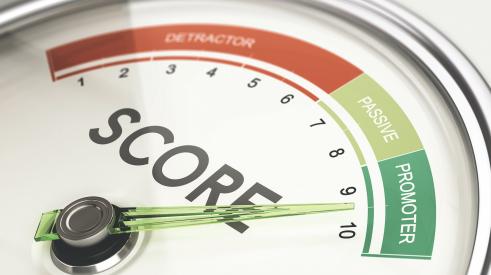|
Paul Cardis
paul.cardis@avidratings.com
|
In the September 2003 Professional Builder, I outlined best practices that lead to superb customer satisfaction: Know your customers, create relationship value, develop a wow factor, practice inoculation, set realistic expectations, make smooth transitions and abolish “survey talk.” This is the first in a series of articles that will explore these best practices in greater detail.
Satisfaction is the state of being happy, content, pleased and delighted. Most major businesses focus on getting customers to this state of bliss before, during and after the sale. In the home building industry, there is good reason to do so — the J.D. Power survey, which ranks builders among their peers. Savvy customers can see the results in the media and on the Web before making a new home purchase decision. So the question is: How do you get to the top?
As you might know, Pulte Homes dominated the 2003 results, finishing first or tied for first in 12 of the 21 markets surveyed. In addition to leading their respective markets in the J.D. Power rankings, Pulte Homes of Phoenix won a Diamond Award in the 2003 NRS Award in Homeowner Satisfaction competition for the best score among all production builders, and Pulte Homes of Minnesota earned an Excellence Award as the runner-up in its size classification.
How does Pulte clearly separate itself from others in this critical area? As PB contributing editor Scott Sedam pointed out in his December column, it’s not through warranty service. Although warranty service is important, it’s not enough to generate the high level of referrals enjoyed by this customer satisfaction leader. (In our NRS Award analysis, Pulte Phoenix had a 96.4% referral rating and 4.78 referrals per customer.)
Customer satisfaction begins before the sale. Most businesses don’t do what they should to maximize their satisfaction scores. Market leaders design their marketing and sales programs to Sell for SatisfactionTM. Are your sales and marketing programs doing the most in this area?
The builders that score best in customer satisfaction know their customers, which enables them to target their design and marketing to buyers who will be happiest with them. But equally important is how builders sell. Hopefully these primers will help your team get on track.
|
Key Points of Selling for Satisfaction
Selling for satisfaction means:
|
Better Know Your Customer
Most builders don’t really know who their best customers are, and more important, most don’t use the selling strategies they need to set themselves up for satisfaction success. Your customers shouldn’t include every buyer looking to build a new abode. For example, you probably can’t please a custom home buyer who wants to participate in the entire building process. Indeed, you might want to punt this prospect to the competition because you have no chance of making this customer happy.
The best companies in customer satisfaction hold their salespeople accountable for this task. Knowing who your right customers are requires a lot of deliberation, which, if done properly, results in knowing the type of builder you want to be.
This self-reflection requires more than a mission statement or marketing study that guides the actions of your entire staff. It requires a detailed analysis of who your best customers are and why. It is a process by which you decide which customers you want from the onset and which ones are not right for your company/project.
The basic process is as follows:
1) Determine the type of customer you’re after.
2) Increase sales to those who are a “good fit.”
3) Have an action plan for dealing with those who are a “bad fit” (which includes if they are a better fit elsewhere in your company or with a competitor).
Most people don’t realize that such an approach, when done properly, actually increases sales! Remember, it’s the big builders that dominate the top of the list in customer satisfaction.
Without such an approach, you likely will take on buyers who will be less satisfied, risking long-term satisfaction issues that can backlash your company. Satisfaction sells homes. That is your trump card in a tight market.
Is your staff as good as your competition’s in this area? Or are you receiving their punts across town and losing your trump?
Pulte does this well. It has a national program that enables its sales and marketing staffs to better identify and attract what Pulte calls “targeted consumer groups.”
Once you define your company and your customers, you need a well-oiled machine that sells in a way to promote high satisfaction and customer loyalty.
The essence of selling for satisfaction is the art of selling solutions geared toward the best interest of the customer. When your customers believe they made a great decision to buy from you and you reinforce that decision by exceeding their expectations, you have the formula for creating the most loyal customers you could want. Moreover, customers who have this experience are so loyal and so proud of their decision that they will work with you when things don’t go as planned.
Selling in a way that promotes this kind of customer delight requires more than a friendly smile, good conversation and a cookie. Selling that promotes this level of satisfaction means selling for perceived solutions that can and will be delivered.
When your sales force has these goals as a priority and a system to monitor them, you have a much higher probability of success in satisfying your customers in the weeks and months to follow.
Utopia? Not if your method of compensating salespeople works against you. What is the most common incentive program for salespeople in the home building industry? Hint: It doesn’t include satisfaction levels. Although salespeople are the gatekeepers to customer satisfaction, many companies still fail to tie satisfaction results to the sales force’s compensation. Surely more companies are including satisfaction data in the equation, and we applaud their efforts.
But compensation programs are not the magic bullet. You need continual education and organizational support plus compensation to enable your staff to deliver this kind of selling. Our research shows that the best builders in customer satisfaction do more than other builders in this area. Instinctively or by design, they facilitate a high degree of customer loyalty that the rest of the company reinforces. This yields mostly happy customers and a tenfold return on investment.
Paul Cardis is CEO of Madison, Wis.-based NRS Corp., which provides customer satisfaction research and consulting.
To begin a successful satisfaction journey, you must know who your customers are and know why you are able to satisfy them.
- Do you have a measurement system in place to gauge your customers’ perceptions on an ongoing basis? If not, establish one.
- Examine your data and ask yourself and your team about what your customers want and what things really tick off customers.
- How well can you predict whether you can meet and exceed expectations for the customer groups you have identified?
- Is there a certain group you satisfy more than other groups? If so, design ways to increase traffic from and grow that customer base. If not, evaluate what your market is and whether it makes sense to sell a product to the “not-so-good customer base.”
- Consider how soon you can change the delivery to the not-so-good customer base to result in satisfaction. How long before improvements take effect, and what strategies can be employed in the meantime?
- What plan is in place for dealing with customers viewed as “not a good fit”? Are other communities within or outside your company a “good fit” for a customer who didn’t meet your profile?
- Do you account for satisfaction in your land-planning and design decisions, or is it just about maximizing margins? Don’t forget about the residual effect of satisfaction that gives your company a huge return on investment in the long run.
Advertisement
Related Stories
Sales + Marketing
6 Keys to a Recognition Program That Improves the Customer Experience
Follow these steps to create and implement a program that rewards your superstars and boosts your CX scores and referrals
Customer Satisfaction
Strive for Perfection
Even an attempt at perfection is difficult, but if you set perfection as your company's goal and everyone involved strives for it, you'll be winning against the competition, regardless
Sales + Marketing
Customer Experience Metrics: How Builders Can Use NPS
When it comes to measuring customer experience, the Net Promoter Score is an underrated and misunderstood metric in the housing industry. Here’s how to use NPS to gauge customer loyalty and boost referral sales






